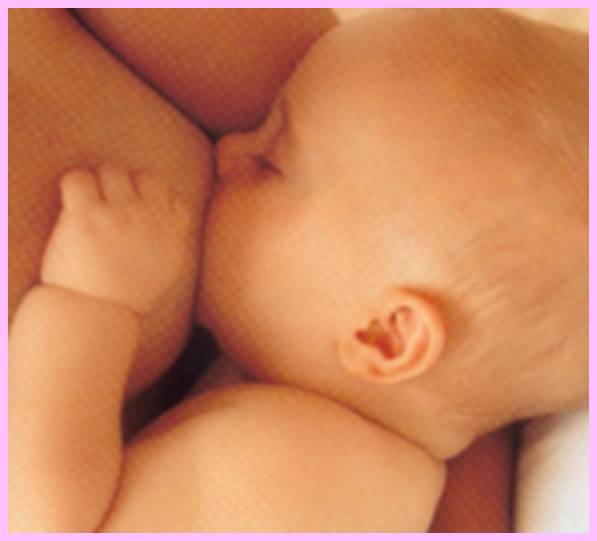|
|
|

|
|

|
| |
|
|
|
Babies
don't care either if they are breast or bottle fed. What is
important for them is to be fed in an happily atmosphere
|
|
|
|
Breastfeeding is a
natural thing to do. Most women can do it, even if your breasts are
small or your nipples are inverted |
|
|
 |
THE
ADVANTAGES : |
|
|
|

|
The
maternal milk fits the best to the baby, because its composition
varies naturally and progressively according to the age of your baby.
Indeed the first milk, called the colostrum,
is yellow, thick and has a high level of protein. Its aim is to purge
the baby's intestine, which is full of meconium.
Some days after, the colour of the milk changes and becomes more
liquid and orange. It is full of lipids and sugar. Around three weeks
after the delivery, the milk suckled by the baby is the final one,
which is composed of all the elements the baby needs to grow.
|
|
|

|
The
milk varies also during the suckling : It is liquid and clear at the
beginning of the suckling, then it becomes thicker and fatter.
|
|
|

|
The
maternal milk contains the mother's antibodies against virus like
poliomyelitis but also against intestine germs, like this of gastro-
enteritis . That is why a breastfed child is less ill than a bottle
fed one. The colostrum is full of all types of antibodies. That's why
it is good to breastfeed during the first days of your baby even if
you move some days after to bottle feeding. |
|
|

|
Maternal
milk is antibacterial. It contains the right level of minerals,
proteins, sodium, and fat for the new born baby. |
|
|

|
The
taste of the maternal milk changes according to the mother's
nutrition. |
|
|

|
Breastfeeding
helps the mother to lose fat and weight rapidly. It also helps the
uterus to go back to its normal place and size. |
|
|

|
Breastfeeding
can create a stronger bond between the baby and her mother. |
|
|

|
Milk
in your breast is always available. It is always pure, so you don't
need to sterilize it, except if you use a breast-pump. Moreover
it always has the right temperature and is economical. |
|
|
|
|
|
 |
THE
DISADVANTAGES : |
|
|
|

|
Always
being available for giving the suck. That is the major problem. But
you can pump off the milk of your breast thanks to a breast pump (electric
or manual) and then the milk can be given to your baby when you are
absent. Your milk has to be put into sterile bottles, put into the
refrigerator and then freeze it. Once frozen, you can keep during
three months.
|
|
|

|
The
mom doesn't know how much the baby has taken. But don't worry about it,
when your baby stops suckling it's because she has enough suckled.
Moreover the pedestrian who will follow your baby will weigh her
during the compulsory visits.
|
|
|
|
|
|
 |
THE
PROCESS : |
|
|
|
| During
her first days, the baby suckles around seven or eight times per 24
hours.
|
|
|

|
If
you have opt for the breastfeeding, the nurse will put your baby to
your breast few minutes after the delivery. The baby instinctively
knows how to suckle.
|
|
|

|
The
first days you will put your baby on each breast during around 10
minutes. It thus prepares your breasts to the lactation production.
Around day 3 your breasts are bigger, full of milk. At this stage you
can just give one breast at one suckle and the other breast at the
next one. Thus the milk production is renewed. Since then, you will
always alternate the breast. |
|
|

|
After
having cleaned your nipples, you can put your baby to your breast. You
have to find a comfortable position, either in the bed putting pillows
around you, or in an armchair. You can even lie down for the suckling.
The thing to remember is to put your baby in a perpendicular position
to your breast, the nipple and the areola have to be in your baby's
mouth. |
|
|

|
After
feeding your baby, hold her in an upright position to allow her to
burp. You can help her by patting softly her back. |
|
|

|
Sometimes
when the baby finishes to suckle, she spits up. Don' t worry it is
normal even if you think she rejects a lot of milk. However if the
fact of spitting up seems to be painful for your baby, tell it to the
paediatrician. |
|
|
|
|
|
 |
HOW
TO CLEAN YOUR BREAST : |
|
|
|

|
In
order to avoid cracks, you have to get a strict daily hygiene of your
bosom. You have to clean your nipples with (mineral) water before and
after each suckling. It is no need to use soap. Water is enough.
Dry
them
gently by patting them. Be careful because cracks are acused by
wetness. That's why it is also advised to
use your milk drops to clean
your nipples and let it dry in an airy way.
|
|
|

|
You
will wear all day and night a nursing bra, in which you can put a pad
inside. This pad will absorb the milk you may leak. Change the pad
frequently because wet pad or wet nipple favour cracks and sores.
|
|
|

|
If
your breast is hot and painful go and see your doctor. |
|
|
|
|
|
Best viewed in
1024*768
All contents © toulousebabynet Feb 2002
IExplorer 5 & Netscape 4.7
|